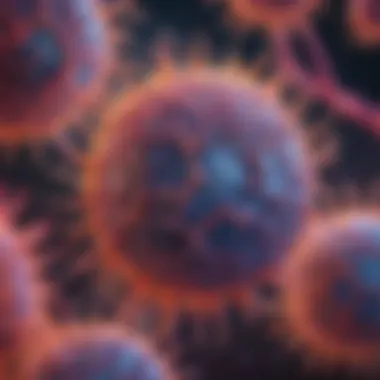Comprehensive Overview of Cancer: Insights and Implications


Intro
Cancer remains one of the most challenging health issues globally, impacting millions of lives. Understanding the biological basis of cancer, alongside its pathophysiological mechanisms, is crucial not only for researchers and health professionals but also for society at large. This article provides a detailed look into cancer, focusing on its diagnosis and treatment options, as well as recent advances in research that aim to improve outcomes for patients. Each section will explore different aspects of cancer, ultimately emphasizing the need for comprehensive knowledge to address its widespread implications.
Research Overview
Methodological Approaches
Research on cancer employs a variety of methodological approaches to study its complexities. Observational studies and clinical trials are fundamental in understanding how cancer develops and progresses. These studies help identify risk factors, efficacy of treatments, and the biological behavior of different cancer types.
In addition, laboratory-based investigations contribute valuable insights into the molecular biology of cancer. Techniques such as genomics and proteomics allow researchers to analyze genetic mutations and protein expression in cancer cells, shedding light on potential therapeutic targets.
Engagement with patient registries also forms a key aspect of cancer research, facilitating long-term studies on treatment outcomes and patient survivorship.
Significance and Implications
The significance of cancer research lies in its potential to save lives and enhance quality of life. By unraveling the intricate details of cancer biology, researchers can develop more effective treatment strategies and personalized medicine approaches. Such advancements can often lead to earlier detection and better management of the disease, which ultimately transforms the prognosis for patients.
"Research is the key to unlocking new avenues in cancer treatment and understanding its impact on society."
Furthermore, understanding the implications of cancer on public health is essential. It informs healthcare policies and community support systems that address the needs of patients and their families.
Current Trends in Science
Innovative Techniques and Tools
Recent years have seen technological advancements revolutionizing cancer research and treatment. For instance, immunotherapy has emerged as a pivotal treatment option, harnessing the body's immune system to combat cancer. Techniques such as CAR T-cell therapy show great promise in treating hematological malignancies.
Additionally, targeted therapies that focus on specific genetic alterations are gaining traction. These therapies allow for more effective treatment with potentially fewer side effects compared to traditional chemotherapy.
Interdisciplinary Connections
The fight against cancer increasingly requires interdisciplinary collaboration. Knowledge from genetics, bioinformatics, and even behavioral science works together to inform research agendas. This integrated approach enriches the understanding of cancer and fosters the development of innovative therapies.
Preface to Cancer
Cancer represents one of the most significant challenges in contemporary medicine, striking millions of individuals globally. Its complexity and various manifestations necessitate an in-depth understanding. This section discusses important elements pertinent to cancer, encompassing its nature as a disease, the historical context of cancer research, and modern implications.
Understanding Cancer as a Disease
To truly grasp cancer, one must define it accurately. Cancer is not a single entity, but rather a group of diseases characterized by uncontrolled cell growth. Cells can grow and multiply at an abnormal rate, ignoring the body's normal regulatory mechanisms. This unregulated proliferation leads to the formation of tumors, which can be either benign or malignant. Malignant tumors are the ones that can invade surrounding tissues and spread to other parts of the body through the bloodstream or lymphatic system, a process known as metastasis.
Several factors contribute to the development of cancer. These include genetic predispositions, environmental factors, and lifestyle choices such as diet and physical activity levels. For instance, certain genetic mutations can predispose individuals to specific types of cancer. Additionally, exposure to carcinogens such as tobacco smoke or excessive sun radiation can significantly increase cancer risk.
A substantial focus in cancer research today is on understanding these complex interactions between genetic and environmental factors. This knowledge is critical as it paves the way for improved prevention strategies and personalized treatment options.
Historical Context of Cancer Research
Historically, cancer has been documented since ancient times. The first recorded observations of cancer were made by ancient Egyptians around 1600 BC, as indicated in the Edwin Smith Papyrus. However, it was not until the late 19th and early 20th centuries that significant progress was made in understanding cancer as a biological phenomenon rather than an incurable ailment.
The advent of the microscope allowed researchers to study cancer cells more comprehensively. Developments in histopathology revealed the differences between normal and cancerous cells. This period also saw the establishment of the germ theory of disease, which influenced the investigation into infectious agents as potential cancer triggers.
In recent decades, research has advanced rapidly with the emergence of molecular biology and genetic science. The discovery of oncogenes in the 1970s highlighted the relationship between genetic mutations and cancer development. Furthermore, funding from organizations such as the National Cancer Institute catalyzed substantial research initiatives, leading to innovative treatments and enhanced survival rates for various cancer types.
As we explore the layers of cancer, the historical context provides a grounding perspective on the progress made in this field, underscoring the importance of continuous research. Understanding the evolution of cancer research not only informs current practices but also emphasizes the need for innovative approaches to address the persistent challenge that cancer poses on health systems and societies.
"The history of cancer research is a reflection of humanity's enduring struggle against a complex and formidable adversary."
This foundation will be essential as we delve deeper into the biological mechanisms of cancer, its classification, diagnosis, and impact on patients.
The Biological Basis of Cancer
Understanding the biological basis of cancer is crucial for grasping how this disease affects the body and the various mechanisms driving its progression. Cancer originates when cells undergo changes that disrupt normal regulatory systems. These changes can be numerous, but they often lead to uncontrolled cell growth and division. Studying the biological underpinnings provides insights into how cancers develop, how they can be diagnosed, and what treatment options might be effective.
Cellular Mechanisms of Cancer Development
Cells are the fundamental units of life, and their functioning is dependent on intricate mechanisms. In cancer, these mechanisms can become dysfunctional. The cell cycle, which regulates cell division, may become disrupted. Signals that typically inform cells to stop growth or to undergo apoptosis (programmed cell death) may be ignored. Such dysfunction can lead to the accumulation of cancer cells. An understanding of these cellular mechanisms can lead to targeted therapies that restore normal function, offering hope for better treatment outcomes.


Genetic Mutations and Cancer
Genetic mutations are pivotal in the development of cancer. These alterations can occur in the DNA sequence of genes that regulate cell growth and division. Some mutations may be inherited, while others may arise due to environmental factors like radiation or chemical exposure. The key types of genetic mutations include:
Oncogenes
Oncogenes are mutated versions of normal genes that, when activated, promote uncontrolled cell growth. They can be seen as accelerators for cancerous changes. The hallmark of oncogenes is their ability to drive excessive cell proliferation, making them a focus for targeted cancer therapies. However, targeting oncogenes can be complex, as they may interact with multiple signaling pathways.
Tumor Suppressor Genes
Tumor suppressor genes function as brakes on cell division and prevent tumor development. When these genes are mutated, the regulatory signals are lost, leading to rampant cell growth. One well-known tumor suppressor gene is p53, which is often referred to as the "guardian of the genome" because of its role in preserving genetic stability. The disruption of tumor suppressor genes highlights the intricate balance needed in cellular functions and presents a critical area for research and therapeutic intervention.
DNA Repair Genes
DNA repair genes maintain the integrity of genetic information by fixing mutations that occur in the DNA. When these genes are compromised, the likelihood of accumulating mutations increases, heightening the risk of cancer. Understanding the role of DNA repair genes helps in identifying vulnerabilities in cancer cells, which can be exploited by treatments that target these defective pathways.
The Role of Epigenetics in Cancer
Epigenetics involves changes in gene expression that do not alter the DNA sequence itself. Factors such as environmental influences and lifestyle choices can lead to epigenetic modifications. In cancer, abnormal epigenetic changes can silence tumor suppressor genes or activate oncogenes, contributing to cancer development. Thus, studying epigenetics is vital, offering insights into the mechanisms that influence cancer risk and progression while also opening avenues for innovative therapeutics aimed at reversing epigenetic modifications.
"Understanding the biological basis of cancer is critical, as it informs treatment strategies and helps identify potential interventions that can lead to better patient outcomes."
Cancer Classification
The classification of cancer is a crucial aspect in understanding the disease. It is essential for proper diagnosis, treatment, and management. This classification helps to categorize various types of cancers based on their histological characteristics, which in turn informs the targeted therapies and prognostic outcomes. Recognizing the specific category of cancer a patient has can significantly impact their treatment path and potential outcomes.
Types of Cancer
Different types of cancer exhibit distinct biological behaviors, responses to treatment, and, often, varying prognoses. Below are primary classifications with a focus on key characteristics.
Carcinomas
Carcinomas are the most common type of cancer, originating in epithelial tissues. They account for about 80% of all cancer cases. A key characteristic of carcinomas is their ability to invade nearby structures and spread to distant areas through the bloodstream or lymphatic system. This aggressiveness makes understanding carcinomas particularly beneficial for discussions around cancer.
One unique feature of carcinomas is their wide array of subtypes, including adenocarcinoma and squamous cell carcinoma. Each subtype has its specific biological behavior and treatment response. While treatment for carcinomas often involves surgery and chemotherapy, these options can result in significant side effects, thereby presenting challenges for patients.
Sarcomas
Sarcomas arise from connective tissues, like muscle, fat, or bone. They are less common than carcinomas, accounting for about 1% of all cancers. The key characteristic of sarcomas includes their varied histological types, which complicates their diagnosis and management. These tumors do have a unique feature of being often more localized and may not spread as aggressively as some carcinomas, presenting a potential advantage in treatments aimed at removing localized tumors.
However, the rare nature of sarcomas means they are often less understood, which can lead to difficulties in timely diagnosis and commencement of effective treatment.
Lymphomas
Lymphomas originate in lymphatic tissues, including lymph nodes and the spleen. The two main types are Hodgkin's lymphoma and non-Hodgkin's lymphoma. A defining characteristic is their relation to the immune system, which makes them unique compared to other cancers.
This aspect promotes a different approach to treatment, often involving immunotherapy and targeted therapies. The management of lymphomas can be very effective in many cases, which is why understanding lymphomas is significant in discussions of cancer treatment.
Leukemias
Leukemias are cancers of the blood and bone marrow, characterized by the uncontrolled growth of abnormal white blood cells. They vary by type, mainly categorized into acute and chronic forms. A key feature is how rapidly they develop; acute leukemias progress quickly, requiring immediate attention and intervention.
Understanding leukemias is vital because they often present with diverse symptoms and can exhibit rapid changes in health status for patients. This can complicate treatment efforts, requiring a tailored approach for each patient depending on the subtype.
Staging and Grading of Cancer
Staging and grading are fundamental components of cancer classification. Staging refers to determining the extent of cancer spread in the body, while grading assesses the appearance of cancer cells compared to normal cells. Together, they provide essential prognostic information that aids in treatment decisions and patient management.
Diagnosis of Cancer
Diagnosis of cancer is a critical step in the pathway to effective treatment. Early detection can significantly improve the chances of successful intervention and management. Understanding the various diagnostic methods available helps in tailoring a patient’s treatment plan and in providing informed consent. It is vital for healthcare providers to be well-versed in these techniques, as they directly impact patient outcomes.
Diagnostic Tools and Techniques
Imaging Techniques
Imaging techniques encompass a variety of methods used to visualize the inside of the human body. Common modalities include X-rays, CT scans, MRI, and ultrasound. These methods help to identify tumors, assess their size, and determine their location. The key characteristic of imaging techniques is their non-invasive nature, making them a preferred option for initial assessment.


Advantages: Imaging provides critical information that often dictates the course of treatment, offering a clear view of the disease’s progression.
Disadvantages: These techniques may not always differentiate between benign and malignant growths, leading to possible false positives. Furthermore, repeated exposure to radiation from certain imaging methods may carry additional risks.
Biopsy Procedures
A biopsy involves taking a small sample of tissue for examination. This is often considered the gold standard for diagnosing cancer. The primary advantage of biopsy is its ability to provide definitive information on whether a lesion is cancerous. There are several types of biopsy procedures, including needle biopsies, excisional biopsies, and endoscopic biopsies.
The unique feature of biopsy procedures is their specificity. They can determine the cellular type of the tumor, which is essential for determining the appropriate treatment approach.
Advantages: Accurate diagnosis is crucial, and biopsy plays a fundamental role in confirming malignancy.
Disadvantages: Biopsies can be invasive, leading to discomfort or complications. Additionally, there may be limitations in accessibility depending on the tumor’s location.
Genetic Testing
Genetic testing involves analyzing DNA to look for mutations that can lead to cancer. This can provide significant insight, especially in familial cancer syndromes. The key characteristic of genetic testing is its ability to identify inherited risks, thus guiding personalized treatment plans.
Advantages: Understanding the genetic profile can assist not just in treatment decisions but also in prevention strategies for patients and their families.
Disadvantages: The implications of genetic testing can be complex. There may be emotional distress and ethical considerations, such as privacy concerns and possible discrimination based on genetic information.
Challenges in Cancer Diagnosis
The process of diagnosing cancer is fraught with challenges. One notable challenge is the variability in symptoms that can be attributed to a wide range of conditions, often delaying diagnosis. Moreover, the limitations of tests themselves can create uncertainty; for instance, certain imaging techniques may not detect small tumors, while biopsies may miss cancerous cells in sampling errors.
Another complexity lies in the interpretation of results. Different healthcare providers may arrive at varying conclusions based on the same data. This highlights the importance of experience and expertise in cancer diagnostics.
Treatment Modalities for Cancer
Treatment modalities for cancer are critical for multiple reasons. First, they offer patients a range of options tailored to their specific type of cancer and personal health status. Each modality brings its set of benefits, side effects, and considerations that play a major role in treatment outcomes. Understanding these treatments can empower patients and their families in making informed decisions. Furthermore, staying updated on treatment advancements can lead to integration of more effective and less harmful approaches to care.
Surgery as a Treatment Option
Surgery represents one of the oldest and still one of the most effective treatment options available for cancer. Typically, this approach focuses on the physical removal of tumors or affected tissues. The success of surgery often depends on the stage of the cancer and how localized the disease is. For example, in early-stage cancers, complete removal may lead to a cure. However, more advanced stages may present challenges where surgery alone is insufficient.
Surgical techniques continue to evolve. Minimally invasive procedures, such as laparoscopic surgery, reduce recovery time and seem to be less traumatic for patients. Moreover, surgeons may also perform biopsies during surgery to confirm a diagnosis and determine the next steps. Despite its strengths, surgery does come with risks, including infection and complications from anesthesia.
Chemotherapy: Mechanisms and Effectiveness
Chemotherapy employs powerful drugs that kill rapidly dividing cancer cells. This approach has been successful in treating various cancers, especially those that have spread. Chemotherapy can be used as a primary treatment, neoadjuvantly (before surgery), or adjuvantly (after surgery) to eliminate residual cells.
The effectiveness of chemotherapy is often determined by the cancer type, the timing of treatment, and individual patient responses. While many people experience positive outcomes, side effects are common. These can range from nausea to more severe complications, affecting patient quality of life. Research is ongoing to develop more targeted chemotherapies with fewer adverse effects.
Radiation Therapy
Radiation therapy uses high-energy particles or waves to target and kill cancer cells. This method can be employed either as a standalone treatment or in conjunction with surgery or chemotherapy.
Types of Radiation
There are two principal types of radiation: external beam radiation and brachytherapy. External beam radiation delivers radiation from outside the body, targeting the tumor while sparing healthy tissue as much as possible. Brachytherapy involves placing radioactive material directly inside or near the tumor, allowing for high localized doses.
The choice of type often depends on the specific characteristics of the cancer, including its size and location. This specificity can make radiation a beneficial choice, as it can minimize damage to surrounding healthy cells.
Applications in Treatment
Radiation therapy's applications are broad and versatile. It can be used to shrink tumors before surgery, alleviate symptoms in advanced cancer, or eliminate remaining cells after a primary treatment. Its ability to deliver targeted treatment makes it a popular option in many cancer care programs. However, patients must consider potential side effects that may arise from treatment, such as skin irritation or fatigue.
Emerging Therapies
Emerging therapies represent the next frontier in cancer treatment, offering hope for more effective and personalized approaches.
Immunotherapy
Immunotherapy harnesses the body’s immune system to fight cancer. This treatment has dramatically changed the landscape of cancer care by increasing survival rates in several types of cancer. Unlike traditional treatments, it can offer lasting effects that persist long after treatment ends. However, not all patients respond, and some may experience immune-related adverse effects.
Targeted Therapy


Targeted therapy is a type of personalized treatment that focuses on specific molecules and pathways involved in cancer growth. This targeted approach can minimize harm to normal cells, resulting in fewer side effects. Its precision makes it a popular choice in treating cancers driven by specific genetic mutations; however, its high cost can be a barrier to access for some patients.
Personalized Medicine
Personalized medicine is another revolutionary approach, tailoring treatment based on individual genetic information. This strategy considers genetic, environmental, and lifestyle factors, offering hope for improved efficacy and reduced adverse effects. As research progresses, this could become a standard in cancer treatment, but it also raises ethical considerations about genetic data use and access.
Impact of Cancer on Patients
Understanding the impact of cancer on patients is crucial for a comprehensive view of this disease. Cancer affects not only the physical body but also significantly influences emotional and psychological well-being. The implications are multifaceted, affecting the lives of patients, their families, and society at large. It is essential to delve into both the physical effects and the psychosocial repercussions to offer a complete perspective.
Physical Effects of Cancer
Cancer can lead to a variety of physical symptoms that directly impact a patient's quality of life. The range of effects can vary widely depending on the type and stage of cancer. Common physical manifestations include:
- Fatigue: This is one of the most frequently reported symptoms among cancer patients. Many experience profound tiredness that does not improve with rest.
- Pain: Cancer can cause pain through tumor pressure on organs or nerves. Pain management is often a critical component of treatment.
- Weight Loss: Unintended weight loss may occur either due to metabolic changes or as a result of symptoms like nausea and loss of appetite.
- Nausea and Vomiting: These side effects can arise from both the disease itself and certain treatment regimens, like chemotherapy.
- Changes in Physical Function: Tumors can disrupt normal bodily functions, leading to difficulties in movement or other activities of daily living.
"The physical toll of cancer can significantly reduce a person's ability to engage in everyday activities."
Patients often require supportive care to help manage these physical effects. This may include pain management, nutrition support, and physical therapy. Addressing these physical symptoms is essential in improving overall outcomes.
Psychosocial Implications
The psychological and social dimensions of cancer are profound and complex. Patients often grapple with feelings of anxiety, fear, and depression as they navigate their diagnosis, treatment, and recovery. Key psychosocial implications include:
- Anxiety and Depression: Many individuals experience significant mood changes following a cancer diagnosis. The fear of disease progression or recurrence can be overwhelming.
- Social Stigmas: Cancer can carry social stigmas that isolate patients, impacting their relationships with friends, family, and coworkers.
- Impact on Relationships: The strain of cancer can alter family dynamics. Partners and children may feel neglected or overwhelmed, changing the structure of family roles.
- Economic Burden: The financial impact of cancer can add to emotional stress, leading to anxiety over medical bills or job loss.
- Support Systems: Access to strong support networks can mitigate some psychosocial effects. Support groups, therapeutic counseling, or community resources play a vital role in helping patients cope.
Cancer Research and Future Directions
Cancer research is at the forefront of medical science and plays a crucial role in understanding this complex disease. The necessity for continual exploration and advancement in this area cannot be understated. Given that cancer is a leading cause of death globally, research not only aims at improving treatment outcomes but also at uncovering the underlying mechanisms responsible for cancer initiation and progression. As such, future directions in cancer research promise to revolutionize our approach towards oncology.
Current Trends in Cancer Research
Current trends reflect a multidisciplinary approach towards cancer research, incorporating genetics, molecular biology, and advanced imaging techniques. One significant trend is the rise of personalized medicine, where treatments are tailored based on individual patient profiles, particularly their genetic makeup. This approach seeks to increase efficiency in treatment plans and minimize adverse effects. Studies show that drugs can achieve better outcomes when aligned specifically to the molecular phenotypes of tumors.
Another trend is the emphasis on early detection through advanced diagnostic tools. Technologies such as liquid biopsies are being explored to detect cancer through a simple blood test that analyzes circulating tumor DNA. This method could lead to earlier diagnoses and better prognoses.
Current advancements in immunotherapy continue to gain momentum, providing new hope for patients with types of cancer that were previously difficult to treat.
The Role of Technology in Cancer Research
Technological innovations are transforming how cancer is researched and treated, leading to more effective strategies for combating the disease.
Artificial Intelligence
Artificial Intelligence (AI) has emerged as a key player in cancer research. One specific aspect of AI is its ability to analyze vast amounts of data quickly and accurately. This capability enhances research by identifying patterns that may go unnoticed by human analysts.
AI's key characteristic is its data-processing power, which enables researchers to make predictions about cancer outcomes based on myriad patient factors. This quality makes AI a beneficial tool in this article, as it illustrates the forefront of current methodologies.
However, the unique feature of AI is its continuous learning ability. As it processes more data, its predictions become more precise, yielding advantages such as improved diagnostic accuracy and personalized treatment plans. The main disadvantage lies in ensuring data privacy and addressing potential biases in AI algorithms that may skew results.
Biotechnology Advances
Biotechnology advances, including genome editing and monoclonal antibodies, represent a significant leap forward in cancer therapies. One notable aspect is CRISPR technology, which allows researchers to edit genetic material with precision. This development could pave the way for targeted therapies that disrupt cancer cell functions at the genetic level.
The key characteristic of biotechnology advances is their innovative applications in therapeutic development. They are a significant choice for this discussion as they represent the cutting edge of cancer treatment options.
The unique feature of biotechnology is its capacity for high specificity, reducing the collateral damage that traditional therapies sometimes cause to healthy cells. Nevertheless, challenges such as ethical considerations and regulatory hurdles remain a concern.
End
Understanding cancer is an essential endeavor given its vast implications on both individual health and society as a whole. As explored throughout the article, cancer is not merely a single disease but a complex group of disorders that arise from various biological mechanisms. The insights gained from a comprehensive overview of cancer, including its biological basis, diagnostic challenges, treatment modalities, and psychosocial effects, highlight the importance of an informed approach to this pervasive issue.
Summary of Key Insights
Several key insights emerge from this exploration:
- Complex Nature of Cancer: Cancer is characterized by diverse types and behaviors, necessitating a multifaceted analysis for effective management.
- Biological Mechanisms: Understanding the cellular and genetic underpinnings of cancer aids in developing targeted therapies. Research has shown the critical roles of oncogenes, tumor suppressor genes, and epigenetic modifications in cancer progression.
- Challenges in Diagnosis: Early detection remains crucial yet challenging. Advancements in imaging, biopsy, and genetic testing have improved diagnostic accuracy but still face limitations.
- Diverse Treatment Options: The evolution of cancer treatment, from traditional surgery and chemotherapy to innovative immunotherapies and personalized approaches, demonstrates ongoing progress in enhancing patient outcomes.
- Societal Impact: Cancer affects not only those diagnosed but also families and communities, highlighting the need for supportive measures and public health initiatives.
The Importance of Continued Research
Continued research in the field of oncology is vital for several reasons:
- Advances in Understanding: As science progresses, new discoveries about cancer's mechanisms are routinely made. These insights have the potential to unveil previously unknown pathways for intervention.
- Development of Novel Therapies: Ongoing research contributes to the discovery and refinement of therapies that increase efficacy while minimizing side effects. Targeted therapies and immunotherapies, for instance, represent significant advancements in treatment paradigms.
- Addressing Unmet Needs: Many cancer types still lack effective treatment options. Research can identify gaps and facilitate the development of solutions that may lead to better care.
- Personalizing Medicine: By exploring genetic variations and responses to treatment, research can directly inform personalized medicine approaches, optimizing therapy based on individual patient profiles.
- Public Health Implications: Research findings can guide policy-making and resource allocation, improving access to care and addressing health disparities.



